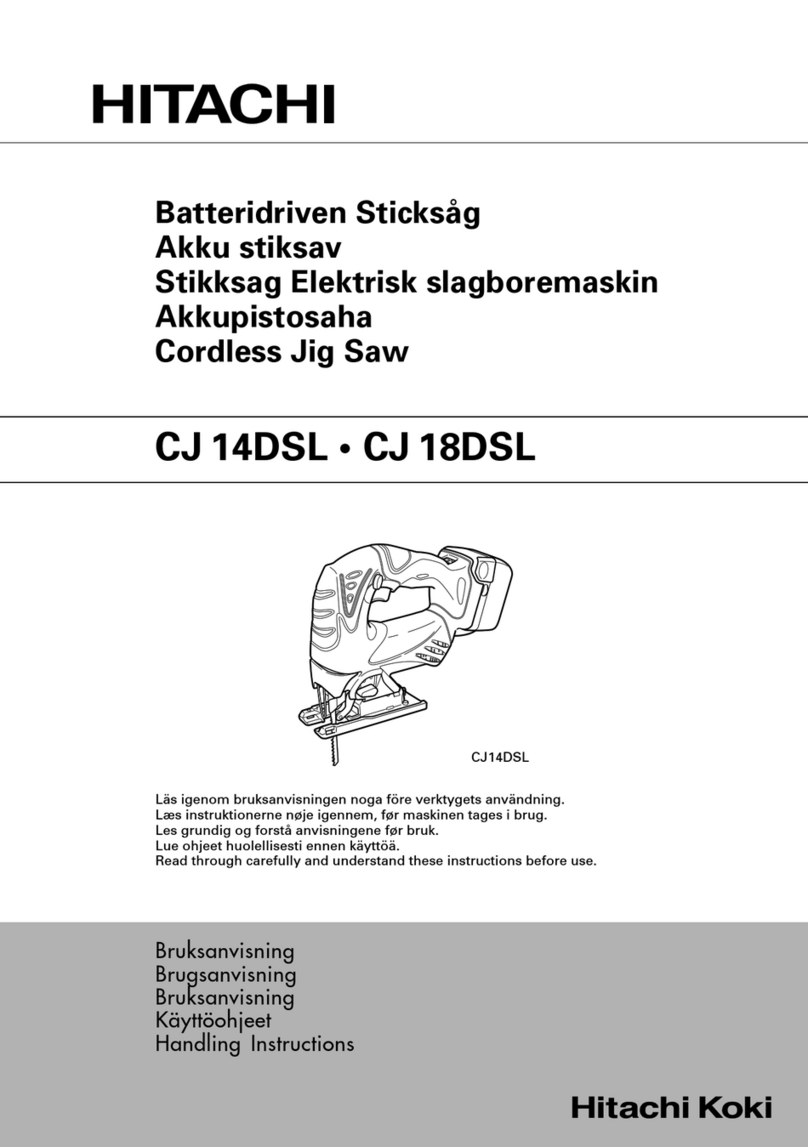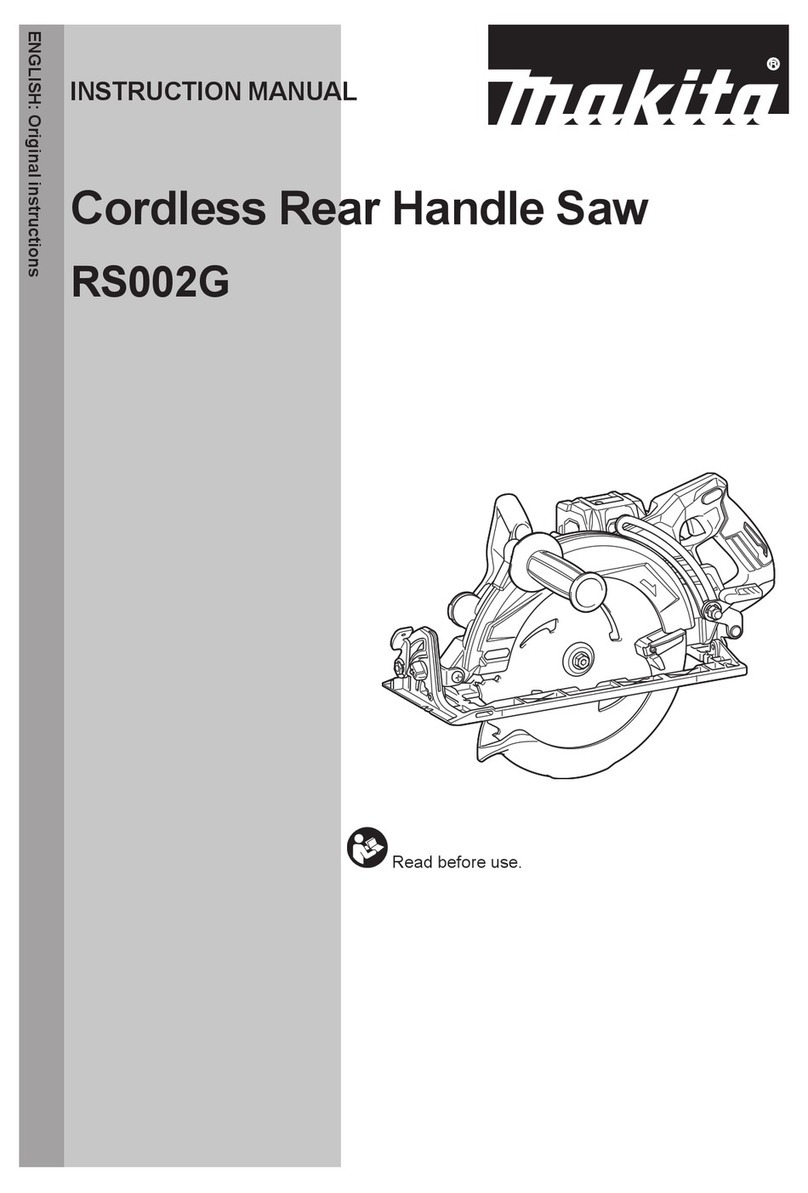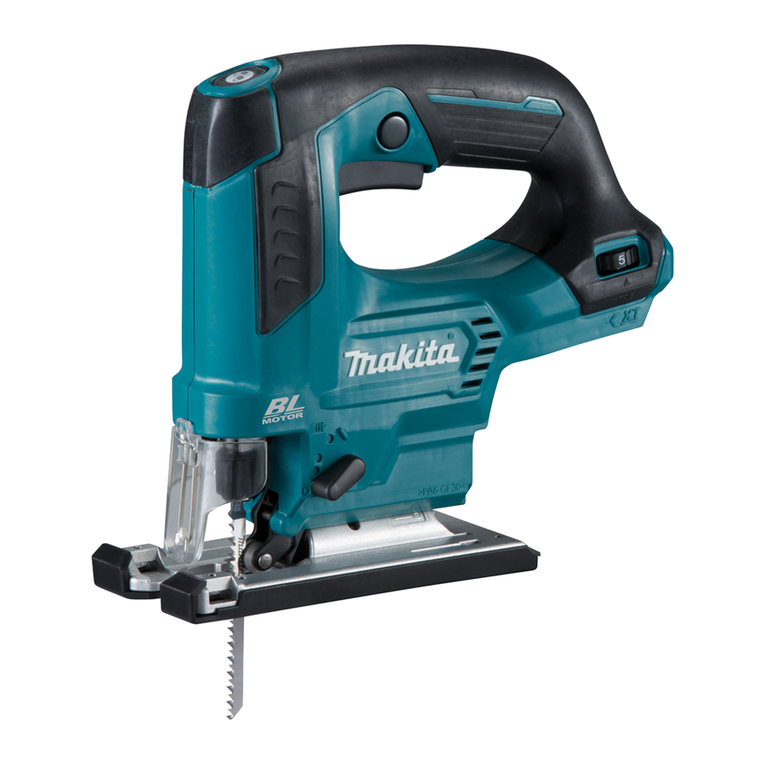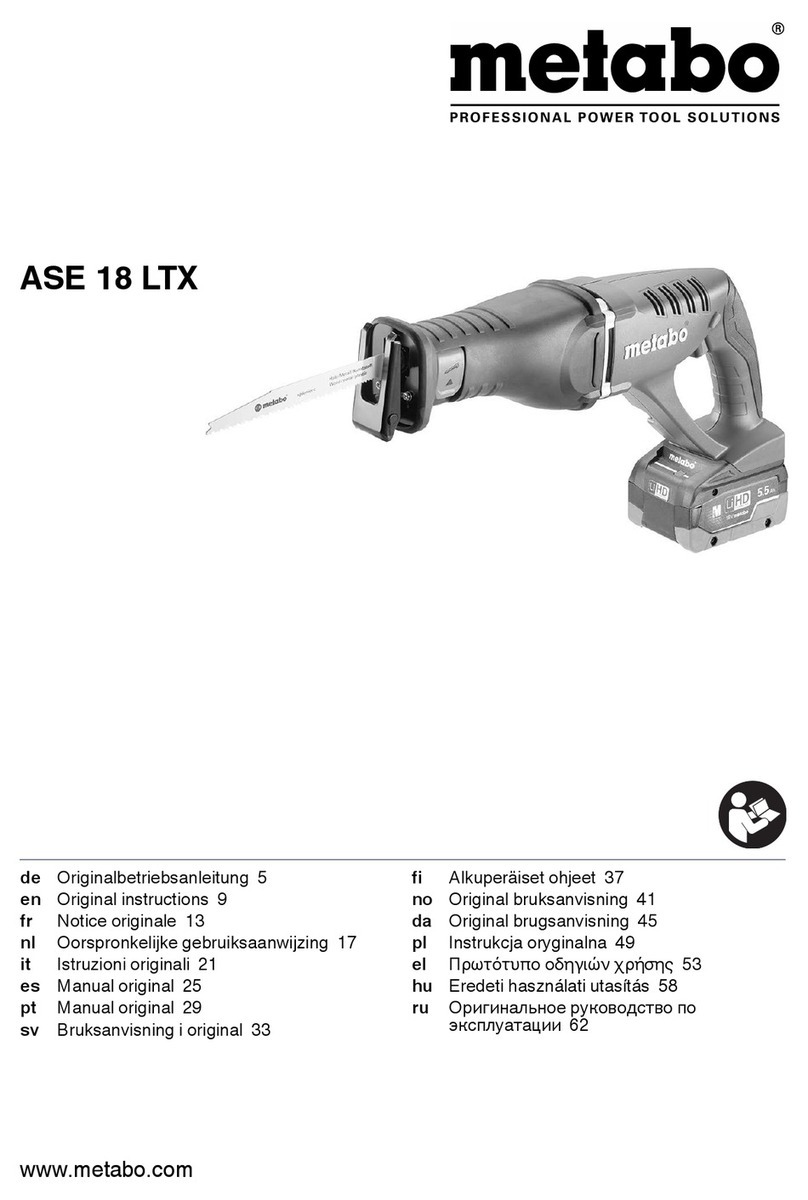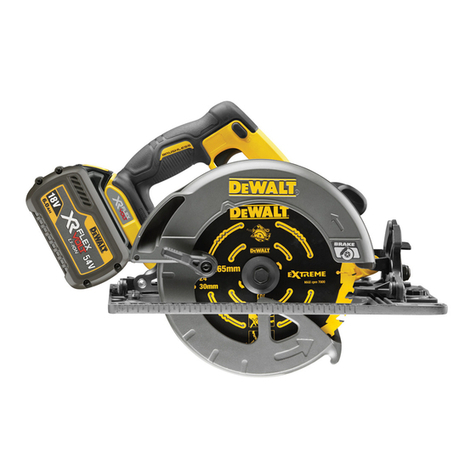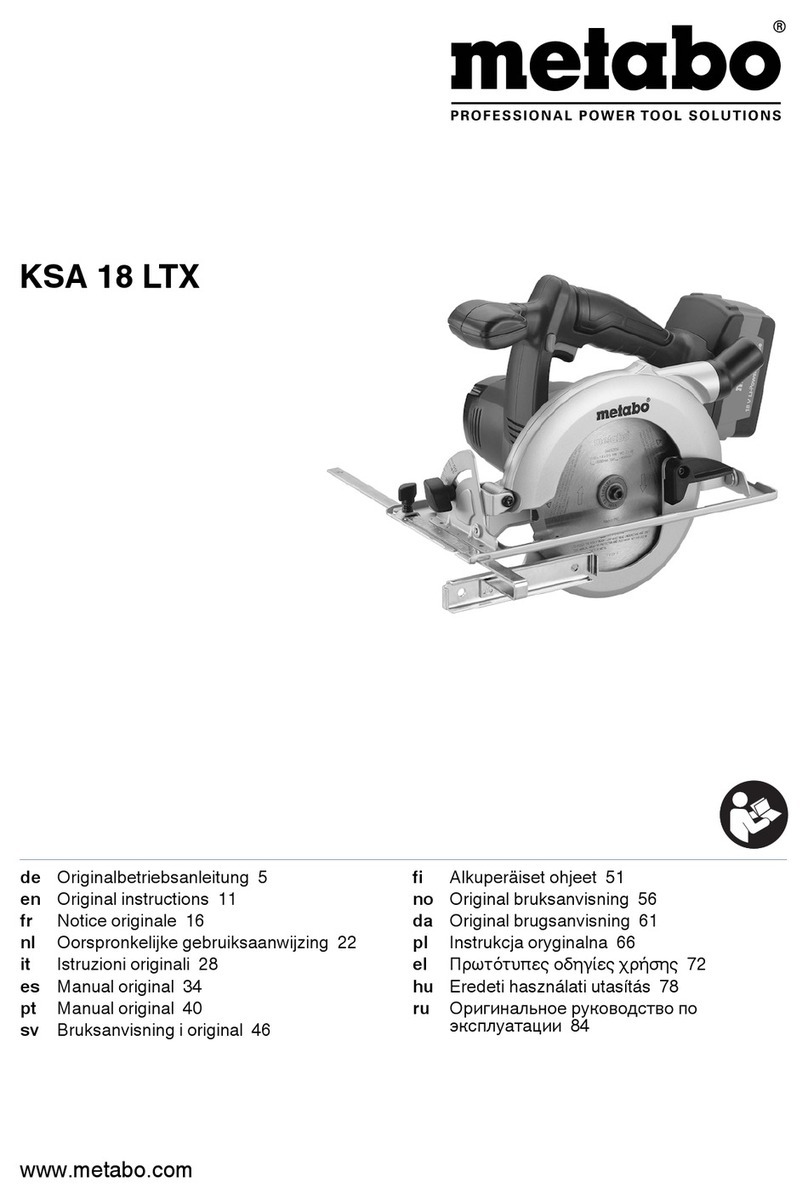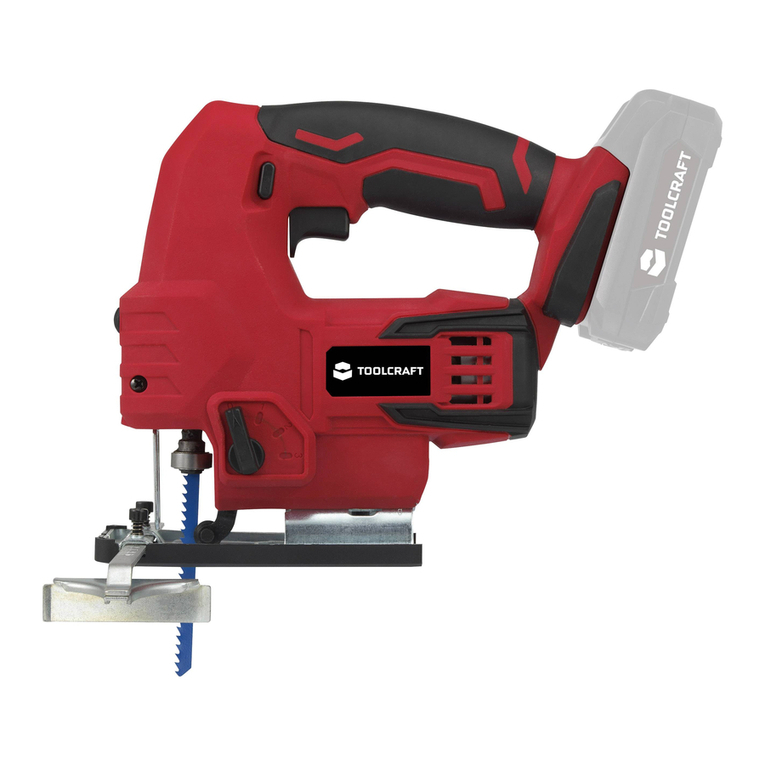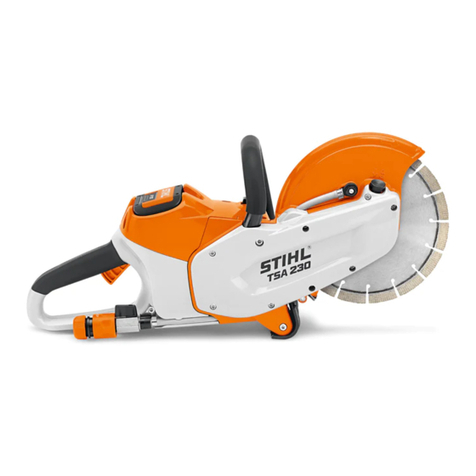Hitachi Koki CJ 18DSL User manual

Cordless Jig Saw
充電式線鋸機
충전 직쏘
Máy cưa lọng dùng pin
CJ 14DSL •CJ 18DSL
CJ14DSL
Read through carefully and understand these instructions before use.
使用前務請詳加閱讀
본 설명서를 자세히 읽고 내용을 숙지한 뒤 제품을 사용하십시오.
Đọc kỹvà hiểu rõ các hướng dẫn này trước khi sửdụng.
โปรดอานโดยละเอียดและทําความเขาใจกอนใชงาน
Handling instructions Hướng dẫn sửdụng
使用說明書 คูมือการใชงาน
취급 설명서
000BookCJ14DSLAra.indb1000BookCJ14DSLAra.indb1 2012/07/1015:40:132012/07/1015:40:13

2
1
#
#
89
)
1
2
0
$
e
7
6
$
%
@
@
(
^
#
*
&
r
w
e
q
t
y
<BSL1430> <BSL1830>
!
3
4
1
2
5
!
#
%
123
456
789
10 11 12
000BookCJ14DSLAra.indb2000BookCJ14DSLAra.indb2 2012/07/1015:40:142012/07/1015:40:14

3
m
e
u
t
o
v
a
p
u
i
n
e
sfd
g
x
h
j
k
l
;
z
d
g
e
c
e
t
v
xc
eb
a
e
13 14 15
16 17 18
19 20 21
22 23 24
000BookCJ14DSLAra.indb3000BookCJ14DSLAra.indb3 2012/07/1015:40:162012/07/1015:40:16

4
English 中國語 한국어
1Rechargeable battery 充電式電池 충전식 배터리
2Latch 卡榫 래치
3Battery cover 電池蓋 배터리 커버
4Terminals 端子 단자
5Ventilation holes 散熱孔 통풍구
6Handle 握把 핸들
7Insert 插入 삽입
8Pull out 拉出 잡아당김
9Charger 充電器 충전기
0Pilot lamp 指示燈 파일럿 램프
!Line 線라인
@Lever 槓桿 레버
#Blade 鋸片 톱날
$Blade holder 鋸刀架 톱날 고정
%Roller 軋輥 롤러
^Lock offbutton 鎖閉按鈕 잠금 버튼
&Lock 鎖定 잠금
*Free 未固定的 작동
(Switch 開關 스위치
)LED Light LED燈 LED 조명
qChange knob 轉換旋鈕 조절자
wSplinter guard 碎屑防護罩 작업 표면 보호대
eBase 底座 베이스
rInsert 安裝 삽입
tChip cover 碎片防護蓋 톱밥 커버
yInsert 安裝 삽입
uOpen 打開 오픈
iRemaining battery indicator switch 電池剩餘量指示開關 배터리 잔량 표시 스위치
oRemaining battery indicator lamp 電池剩餘量指示燈 배터리 잔량 표시등
pBase bolt 底座螺栓 중앙 볼트
aHexagonal bar wrench 六角棒形扳手 육각 렌치
sForward 向前 진행 방향
dGuide 導架 가이드
fAttachment hole 安裝孔 부착 구멍
gM5 bolt M5螺栓 M5 볼트
hNail or screw 螺釘或螺絲 못 또는 나사
jGuide hole 導孔 가이드 구멍
kScale 刻度 눈금
lSemi-circular part 半圓形部分 반원 부분
;-mark -記號 -표시
zCleaner 清潔器 청소기
xDust collector 集塵器 먼지 집진기
cAdapter 附加器 어댑터
vNose 接頭 결합부
bRear hole 後方孔 후방 구멍
nHook 勾腳 후크
mNotch 槽口 노치
000BookCJ14DSLAra.indb4000BookCJ14DSLAra.indb4 2012/07/1015:40:162012/07/1015:40:16

5
Tiếng Việt
1Pin sạc
2Chốt
3Nắp pin
4Đầu cuối
5Các lỗthông gió
6Cầm
7Chèn
8Kéo ra
9Bộsạc
0Đèn báo
!Dây dẫn
@Cần gạt
#Lưỡi cưa
$Kẹp lưỡi cưa
%Trục lăn
^Khóa nút bấm
&Khóa
*Mở
(Công tắc
)Đèn LED LED
qThay đổi núm vặn
wTấm chắn mảnh vụn
eChân đế
rChèn
tVỏbọc con chip
yChèn
uMở
iCông tắc đèn báo lượng pin còn lại
oĐèn báo lượng pin còn lại
pBu lông bắt đế
aCờlê thanh sáu cạnh
sRa trước
dThanh dẫn hướng
fLỗkhoan cốđịnh
gBu lông M5 M5
hĐinh hoặc vít
jLỗkhoan dẫn hướng
kThang đo
lBộphận bán nguyệt
;Dấu
zMáy quét
xMáy hút bụi
cBộtiếp hợp
vMũi
bLỗkhoan sau
nLưỡi câu
mRãnh cắt
000BookCJ14DSLAra.indb5000BookCJ14DSLAra.indb5 2012/07/1015:40:172012/07/1015:40:17

English
6
GENERAL SAFETY RULES
WARNING!
Read all instructions
Failure to follow all instructions listed below may result in
electric shock, fire and/or serious injury.
The term “power tool” in all of the warnings listed below
refers to your mains operated (corded) power tool or battery
operated (cordless) power tool.
SAVE THESE INSTRUCTIONS
1) Work area
a) Keep work area clean and well lit.
Cluttered and dark areas invite accidents.
b) Do not operate power tools in explosive
atmospheres, such as in the presence of
flammable liquids, gases or dust.
Power tools create sparks which may ignite the dust
of fumes.
c) Keep children and bystanders away while
operating a power tool.
Distractions can cause you to lose control.
2) Electrical safety
a) Power tool plugs must match the outlet.
Never modify the plug in any way.
Do not use any adapter plugs with earthed
(grounded) power tools.
Unmodified plugs and matching outlets will reduce
risk of electric shock.
b) Avoid body contact with earthed or grounded
surfaces such as pipes, radiators, ranges and
refrigerators.
There is an increased risk of electric shock if your
body is earthed or grounded.
c) Do not expose power tools to rain or wet
conditions.
Water entering a power tool will increase the risk of
electric shock.
d) Do not abuse the cord. Never use the cord for
carrying, pulling or unplugging the power tool.
Keep cord away from heat, oil, sharp edges or
moving parts.
Damaged or entangled cords increase the risk of
electric shock.
e) When operating a power tool outdoors, use an
extension cord suitable for outdoor use.
Use of a cord suitable for outdoor use reduces the
risk of electric shock.
3) Personal safety
a) Stay alert, watch what you are doing and use
common sense when operating a power tool.
Do not use a power tool while you are tired
or under the influence of drugs, alcohol or
medication.
A moment of inattention while operating power tools
may result in serious personal injury.
b) Use safety equipment. Always wear eye
protection.
Safety equipment such as dust mask, non-skid
safety shoes, hard hat, or hearing protection used for
appropriate conditions will reduce personal injuries.
c) Avoid accidental starting. Ensure the switch is in
the offposition before plugging in.
Carrying power tools with your finger on the switch or
plugging in power tools that have the switch on invites
accidents.
d) Remove any adjusting key or wrench before
turning the power tool on.
A wrench or a key left attached to a rotating part of the
power tool may result in personal injury.
e) Do not overreach. Keep proper footing and
balance at all times.
This enables better control of the power tool in
unexpected situations.
f) Dress properly. Do not wear loose clothing or
jewellery. Keep your hair, clothing and gloves
away from moving parts.
Loose clothes, jewellery or long hair can be caught in
moving parts.
g) If devices are provided for the connection of
dust extraction and collection facilities, ensure
these are connected and properly used.
Use of these devices can reduce dust related
hazards.
4) Power tool use and care
a) Do not force the power tool. Use the correct
power tool for your application.
The correct power tool will do the job better and safer
at the rate for which it was designed.
b) Do not use the power tool if the switch does not
turn it on and off.
Any power tool that cannot be controlled with the
switch is dangerous and must be repaired.
c) Disconnect the plug from the power source
before making any adjustments, changing
accessories, or storing power tools.
Such preventive safety measures reduce the risk of
starting the power tool accidentally.
d) Store idle power tools out of the reach of children
and do not allow persons unfamiliar with the
power tool or these instructions to operate the
power tool.
Power tools are dangerous in the hands of untrained
users.
e) Maintain power tools. Check for misalignment or
binding of moving parts, breakage of parts and
any other condition that may affect the power
tools’ operation.
If damaged, have the power tool repaired before
use.
Many accidents are caused by poorly maintained
power tools.
f) Keep cutting tools sharp and clean.
Properly maintained cutting tools with sharp cutting
edges are less likely to bind and are easier to control.
g) Use the power tool, accessories and tool bits
etc., in accordance with these instructions and
in the manner intended for the particular type
of power tool, taking into account the working
conditions and the work to be performed.
Use of the power tool for operations different from
intended could result in a hazardous situation.
5) Battery tool use and care
a) Ensure the switch is in the offposition before
inserting battery pack.
Inserting the battery pack into power tools that have
the switch on invites accidents.
b) Recharge only with the charger specified by the
manufacturer.
A charger that is suitable for one type of battery pack
may create a risk of fire when used with another
battery pack.
c) Use power tools only with specifically designated
battery packs.
Use of any other battery packs may create a risk of
injury and fire.
000BookCJ14DSLAra.indb6000BookCJ14DSLAra.indb6 2012/07/1015:40:172012/07/1015:40:17

English
7
d) When battery pack is not in use, keep it away
from other metal objects like paper clips, coins,
keys, nails, screws, or other small metal objects
that can make a connection from one terminal to
another.
Shorting the battery terminals together may cause
burns or a fire.
e) Under abusive conditions, liquid may be ejected
from the battery; avoid contact. If contact
accidentally occurs, flush with water. If liquid
contacts eyes, additionally seek medical help.
Liquid ejected from the battery may cause irritation or
burns.
6) Service
a) Have your power tool serviced by a qualified
repair person using only identical replacement
parts.
This will ensure that the safety of the power tool is
maintained.
PRECAUTION
Keep children and infirm persons away.
When not in use, tools should be stored out of reach of
children and infirm persons.
PRECAUTIONS FOR CORDLESS JIG SAW
1. Always charge the battery at a temperature of 0 – 40°C.
A temperature of less than 0°C will result in over charging
which is dangerous. The battery cannot be charged at a
temperature greater than 40°C.
The most suitable temperature for charging is that of 20 –
25°C.
2. When one charging is completed, leave the charger for
about 15 minutes before the next charging of battery.
3. Do not allow foreign matter to enter the hole for
connecting the rechargeable battery.
4. Never disassemble the rechargeable battery and
charger.
5. Never short-circuit the rechargeable battery.
Short-circuiting the battery will cause a great electric
current and overheat. It results in burn or damage to the
battery.
6. Do not dispose of the battery in fire.
If the battery burnt, it may explode.
7. Do not insert object into the air ventilation slots of the
charger.
Inserting metal objects or inflammables into the charger
air ventilation slots will result in electrical shock hazard or
damaged charger.
8. Bring the battery to the shop from which it was purchased
as soon as the post-charging battery life becomes too
short for practical use. Do not dispose of the exhausted
battery.
9. Using an exhausted battery will damage the charger.
10. If the machine is used continuously at low speed, an
extra load is applied to the motor which can result in
motor seizure. Always operate the power tool so that
the blade is not caught by the material during operation.
Always adjust the blade speed to enable smooth cutting.
CAUTION ON LITHIUM-ION BATTERY
To extend the lifetime, the lithium-ion battery equips with the
protection function to stop the output.
In the cases of 1 and 2 described below, when using this
product, even if you are pulling the switch, the motor may
stop. This is not the trouble but the result of protection
function.
1. When the battery power remaining runs out, the motor
stops.
In such case, charge it up immediately.
2. If the tool is overloaded, the motor may stop. In this
case, release the switch of tool and eliminate causes of
overloading. After that, you can use it again.
Furthermore, please heed the following warning and caution.
WARNING
In order to prevent any battery leakage, heat generation,
smoke emission, explosion and ignition beforehand, please
be sure to heed the following precautions.
1. Make sure that swarf and dust do not collect on the
battery.
○During work make sure that swarf and dust do not fall on
the battery.
○Make sure that any swarf and dust falling on the power
tool during work do not collect on the battery.
○Do not store an unused battery in a location exposed to
swarf and dust.
○Before storing a battery, remove any swarf and dust that
may adhere to it and do not store it together with metal
parts (screws, nails, etc.).
2. Do not pierce battery with a sharp object such as a
nail, strike with a hammer, step on, throw or subject the
battery to severe physical shock.
3. Do not use an apparently damaged or deformed battery.
4. Do not use the battery in reverse polarity.
5. Do not connect directly to an electrical outlets or car
cigarette lighter sockets.
6. Do not use the battery for a purpose other than those
specified.
7. If the battery charging fails to complete even when a
specified recharging time has elapsed, immediately stop
further recharging.
8. Do not put or subject the battery to high temperatures or
high pressure such as into a microwave oven, dryer, or
high pressure container.
9. Keep away from fire immediately when leakage or foul
odor are detected.
10. Do not use in a location where strong static electricity
generates.
11. If there is battery leakage, foul odor, heat generated,
discolored or deformed, or in any way appears abnormal
during use, recharging or storage, immediately remove it
from the equipment or battery charger, and stop use.
CAUTION
1. If liquid leaking from the battery gets into your eyes, do not
rub your eyes and wash them well with fresh clean water
such as tap water and contact a doctor immediately.
If left untreated, the liquid may cause eye-problems.
2. If liquid leaks onto your skin or clothes, wash well with
clean water such as tap water immediately.
There is a possibility that this can cause skin irritation.
3. If you find rust, foul odor, overheating, discolor,
deformation, and/or other irregularities when using the
battery for the first time, do not use and return it to your
supplier or vendor.
WARNING
If an electrically conductive foreign object enters the terminals
of the lithium ion battery, a short-circuit may occur resulting
in the risk of fire. Please observe the following matters when
storing the battery.
○Do not place electrically conductive cuttings, nails,
steel wire, copper wire or other wire in the storage
case.
○Either install the battery in the power tool or store
by securely pressing into the battery cover until the
ventilation holes are concealed to prevent short-
circuits (See Fig. 1).
000BookCJ14DSLAra.indb7000BookCJ14DSLAra.indb7 2012/07/1015:40:172012/07/1015:40:17

English
8
SPECIFICATIONS
Cordless Jig Saw
Model CJ14DSL CJ18DSL
Voltage 14.4 V 18 V
Max. Cutting Depth Wood 135 mm Mild Steel 10 mm
No-load speed 0 – 2400 /min
Stroke 26 mm
Min. Cutting Radius 25 mm
Rechargeable battery BSL1430: Li-ion 14.4 V (3.0 Ah 8 cells) BSL1830: Li-ion 18 V (3.0 Ah 10 cells)
Weight 2.3 kg 2.4kg
Charger
Model UC18YRSL
Charging voltage 14.4 V 18 V
Weight 0.6 kg
STANDARD ACCESSORIES
CJ14DSL
(2LSCK)
CJ18DSL
(2LSCK)
1 Blades (No. 41).............................. 1
Refer to Table 5 for use of the blades.
2 Hexagon bar wrench...................... 1
3 Splinter guard................................. 1
4 Chip cover...................................... 1
5 Charger.......................................... 1
6 Battery ........................................... 2
7 Plastic case.................................... 1
8 Battery cover.................................. 1
CJ14DSL (NN)
CJ18DSL (NN)
Without charger, battery, plastic case
and battery cover
Standard accessories are subject to change without notice.
OPTIONAL ACCESSORIES ... Sold separately
(1) Various types of blades
Refer to Table 5 for use of the blades.
(2) Guide
(3) Sub base
(4) Dust collector
Optional accessories are subject to change without notice.
APPLICATIONS
○Cutting various lumber and pocket cutting
○Cutting mild steel plate, aluminum plate, and copper
plate
○Cutting synthetic resins, such as phenol resin and vinyl
chloride
○Cutting thin and soft construction materials
○Cutting stainless steel plate (with No. 97 blade)
BATTERY REMOVAL/INSTALLATION
1. Battery removal
Hold the housing tightly and push the battery latch to
remove the battery (See Fig. 2).
CAUTION
Never short-circuit the battery.
2. Battery installation
Insert the battery while observing its polarities (See
Fig. 2).
CHARGING
Before using the cordless jig saw, charge the battery as
follows.
1. Connect the charger’s power cord to a receptacle.
When the power cord is connected, the charger’s pilot
lamp will blink in red. (At 1-second intervals).
2. Insert the battery into the charger.
Firmly insert the battery into the charger until the line is
visible, as shown in Fig. 3, 4.
3. Charging
When inserting a battery in the charger, charging will
commence and the pilot lamp will light continuously in
red.
When the battery becomes fully recharged, the pilot lamp
will blink in red (At 1-second intervals). (See Table 1)
(1) Pilot lamp indication
The indications of the pilot lamp will be as shown in
Table 1, according to the condition of the charger or the
rechargeable battery.
000BookCJ14DSLAra.indb8000BookCJ14DSLAra.indb8 2012/07/1015:40:172012/07/1015:40:17

English
9
Table 1
Indications of the pilot lamp
The pilot lamp
lights or blinks
in red.
Before
charging Blinks
Lights for 0.5 seconds. Does not light for 0.5
seconds. (offfor 0.5 seconds)
While
charging Lights Lights continuously
Charging
complete Blinks
Lights for 0.5 seconds. Does not light for 0.5
seconds. (offfor 0.5 seconds)
Charging
impossible Flickers
Lights for 0.1 second. Does not light for 0.1
seconds. (offfor 0.1 seconds) Malfunction in the battery or
the charger.
The pilot lamp
lights in green.
Overheat
standby Lights Lights continuously
Battery overheated.
Unable to charge
(Charging will commence
when battery cools).
(2) Regarding the temperatures of the rechargeable battery
The temperatures for rechargeable batteries are as
shown in the Table 2, and batteries that have become
hot should be cooled for a while before being recharged.
Table 2 Recharging ranges of batteries
Rechargeable batteries Temperatures at which the
battery can be recharged
BSL1430, BSL1830 0°C – 40°C
(3) Regarding recharging time
Depending on the combination of the charger and
batteries, the charging time will become as shown in
Table 3.
Table 3 Charging time (At 20°C)
Charger
Battery UC18YRSL
BSL1430, BSL1830 Approx. 45 min.
NOTE:
The charging time may vary according to temperature
and power source voltage.
4. Disconnect the charger’s power cord from the
receptacle.
5. Hold the charger firmly and pull out the battery.
NOTE:
After operation, pull out batteries from the charger first,
and then keep the batteries properly.
How to make the batteries perform longer
(1) Recharge the batteries before they become completely
exhausted.
When you feel that the power of the tool becomes
weaker, stop using the tool and recharge its battery. If
you continue to use the tool and exhaust the electric
current, the battery may be damaged and its life will
become shorter.
(2) Avoid recharging at high temperatures.
A rechargeable battery will be hot immediately after use.
If such a battery is recharged immediately after use, its
internal chemical substance will deteriorate, and the
battery life will be shortened. Leave the battery and
recharge it after it has cooled for a while.
CAUTION
○When the battery charger has been continuosly used,
the battery charger will be heated, thus constituting
the cause of the failures. Once the charging has been
completed, give 15 minutes rest until the next charging.
○If the battery is recharged when it is warm due to battery
use or exposure to sunlight, the pilot lamp map light in
green.
The battery will not be recharged. In such a case, let the
battery cool before charging.
○When the pilot lamp flickers in red (at 0.2-second
intervals), check for and take out any foreign objects
in the charger’s battery installation hole. If there are no
foreign objects, it is probable that the battery or charger
is malfunctioning. Take it to your authorized Service
Center.
PRIOR TO OPERATION
1. Preparing and checking the work environment
Make sure that the work site meets all the conditions laid
forth in the precautions.
2. Checking the battery
Make sure that the battery is installed firmly. If it is at all
loose it could come offand cause an accident.
3. Dust produced in operation
The dust produced in normal operation may affect
the operator’s health. Either of following way is
recommended.
a) Wear a dust mask
b) Use external dust collection equipment.
When using the external dust collection equipment,
connect the adapter with the hose from external dust
collection equipment. (Fig. 23)
4. Changing blades
(1) Open the lever up to the stop. (Fig. 5-arrow )
(2) Remove fitted blade.
(3) Insert new blade up to the stop in the blade holder. (Fig.
5-arrow )
(4) Close the lever. (Fig. 5-arrow ).
CAUTION
○Be sure to switch power OFF and disconnect the battery
from the body when changing blades.
○Do not open the lever when plunger is moving.
000BookCJ14DSLAra.indb9000BookCJ14DSLAra.indb9 2012/07/1015:40:172012/07/1015:40:17

English
10
NOTE:
○Confirm the protrusions of blade inserted to the blade
holder surely. (Fig. 6)
○Confirm the blade located between the groove of roller.
(Fig. 7).
5. Switch Operation (Fig. 8, 9)
○The saw is provided with a lock offbutton on the top of
the handle to prevent the motor from being switched on
inadvertently. Pushing in the lock offbutton to the locked
position prevents the switch from being pulled. Pushing
in the lock offbutton to the free position allows the switch
to be pulled and the motor to operate.
○The number of strokes of the blade can be adjusted to
within the range of 0 to 2400 strokes/minute depending
on the amount the switch is pulled. In addition, releasing
the switch activates a break that stops the blade
immediately.
○When the switch is turned on, an LED lamp lights to
illuminate the end of the blade. This lamp goes out when
the switch is released.
CAUTION
○Always make sure to push in the lock offbutton to the
locked position when not using the saw.
○Do not look directly into the light from the LED lamp.
Continuous and direct exposure to the light from the LED
lamp can injure your eyes.
6. Adjusting the orbital operation
(1) This Jig Saw employs orbital operation which moves
the blade back and forth, as well as up and down. Set
the change knob shown in Fig. 10 to “0” to eliminate the
orbital operation (the blade moves only up and down).
The orbital operation can be selected in 4 steps from “0”
to “ ”.
(2) For the hard material, such as a steel plate, etc.,
decrease the orbital operation. For the soft material, such
as lumber, plastic, etc., increase the orbital operation to
increase work efficiency. To cut the material accurately,
decrease the orbital operation.
7. Cutting stainless steel plates
This Jig Saw can cut stainless steel plates by using No.
97 blade. Carefully read “Concerning cutting of stainless
steel plates” for proper operation.
8. Splinter guard
Using the splinter guard when cutting wood materials will
reduce splintering of cut surfaces.
Insert the splinter guard in the space on the base, and
push it completely. (See Fig. 11)
9. Chip cover
Chip cover prevents chips from flying offand improves
the efficiency of dust collector.
Insert the chip cover between the base and lever, and
push with a slight pressure until it catches in place. (Fig.
12)
When removing chip cover, hold both sides of knob and
slightly open until it can be removed from the Jig Saw.
(Fig. 13).
NOTE:
There is a possibility that chip cover is frosted when
cutting the metal.
10. Sub base
Using the sub base (made from steel) will reduce
abrasion of aluminium base especially in cutting metals.
Using the sub base (made from resin) will reduce
scratching of cut surface. Attach the sub base to the
bottom surface of base by attached 4 screws.
11. About Remaining Battery Indicator
When pressing the remaining battery indicator switch,
the remaining battery indicator lamp lights and the
battery remaining power can be checked. (Fig. 14) When
releasing your finger from the remaining battery indicator
switch, the remaining battery indicator lamp goes off. The
Table 4 shows the state of remaining battery indicator
lamp and the battery remaining power.
Table 4
State of lamp Battery Remaining Power
The battery remaining power is
enough.
The battery remaining power is a half.
The battery remaining power is nearly
empty.
Re-charge the battery soonest
possible.
As the remaining battery indicator shows somewhat
differently depending on ambient temperature and
battery characteristics, read it as a reference.
NOTE:
○Do not give a strong shock to the switch panel or break it.
It may lead to a trouble.
○To save the battery power consumption, the remaining
battery indicator lamp lights while pressing the remaining
battery indicator switch.
CUTTING
CAUTION
○In order to prevent blade dislodging, damage or
excessive wear on the Plunger, please make sure to
have surface of the base plate attached to the work piece
while sawing.
○At low speed do not cut a wood with a thickness of more
than 10 mm or metal with a thickness of more than 1 mm.
1. Rectilinear cutting
When cutting on a straight line, first draw a marking
gauge line and advance the saw along that line. Using
the guide (sold separately) will make it possible to cut
accurately on a straight line.
(1) Loosen the base bolt hexagonal bar wrench attached on
base. (Fig. 15)
(2) Move the base fully forward (Fig. 16), and tighten the
base bolt again.
(3) Attach the guide by passing it through the attachment
hole on the base and tighten the M5 bolt. (Fig. 17)
(4) Set the orbital position to “0”.
NOTE:
To ensure accurate cutting when using the Guide (Fig.
17), always set the orbital position to “0”.
2. Sawing curved lines
When sawing a small circular arc, reduce the feeding
speed of the machine. If the machine is fed too fast, it
could cause the blade to break.
3. Cutting a circle or a circular arc
The guide also will be helpful for circular cutting.
After attaching the guide by same way noted as above,
drive the nail or screw into the material through the
hole on the guide, then use it for an axis when cutting.
(Fig. 18).
000BookCJ14DSLAra.indb10000BookCJ14DSLAra.indb10 2012/07/1015:40:182012/07/1015:40:18

English
11
NOTE:
Circular cutting must be done with the blade
approximately vertical to the bottom surface of the base.
4. Cutting metallic materials
(1) Set the orbital position to “0” or “ ”.
(2) Cut the material at medium speed.
(3) Always use an appropriate cutting fluid (spindle oil, soapy
water, etc.). When a liquid cutting fluid is not available,
apply grease to the back surface of the material to be cut.
5. Pocket cutting
(1) In lumber
Aligning the blade direction with the grain of the wood,
cut step by step until a window hole is cut in the center of
the lumber. (Fig. 19)
(2) In other materials
When cutting a window hole in materials other than
lumber, initially bore a hole with a drill or similar tool from
which to start cutting.
6. Angular cutting
The base can be swiveled to both sides by up to 45° for
angular cutting. (Fig. 20)
(1) Loosen the base bolt by hexagonal bar wrench attached
on base and move the base fully forward. (Fig. 15, 16)
(2) Align the scale (from 0 degrees to 45 degrees by
15-degree increments) of the semi-circular part of the
base with the [ ] mark on the gear cover. (Fig. 21)
(3) Tighten the M5 bolt again. (Fig. 15)
(4) Set the orbital position to “0”.
NOTE:
Angular cutting can not be done when adopting chip
cover or dust collector.
CONNECTING WITH CLEANER
By connecting with cleaner (sold separately) through dust
collector (sold separately) and adapter (sold separately),
most of dust can be collected.
(1) Remove the hexagonal bar wrench from the base.
(2) Move the base fully forward. (Fig. 15, 16)
(3) Attach the chip cover.
(4) Connect the dust collector with adapter. (Fig. 22)
(5) Connect the adapter with the nose of cleaner. (Fig. 22)
(6) Insert dust collector into the rear hole of the base until the
hook catches in the notch. (Fig. 23)
(7) Press the hook to remove the dust collector.
NOTE:
Wear the dust mask additionally, if available.
CONCERNING CUTTING OF STAINLESS STEEL
PLATES
CAUTION
In order to prevent blade dislodging, damage or excessive
wear on the Plunger, please make sure to have surface of the
base plate attached to the work piece while sawing.
When cutting stainless steel plates, adjust the unit as
described below:
1. Adjust the speed.
Blade Thickness of material Speed
No. 97 1.5 – 2.5 mm Middle speed
NOTE:
The higher the speed is, the quicker the material is
cut. But the service life of the blade will be reduced in
this case. When the speed is too low, cutting will take
longer, although the service life will be prolonged. Make
adjustments as desired.
2. Set the orbital position to “0”
NOTE:
When cutting use cutting fluid (oil base cutting fluid) to
prolong the blade’s service life.
SELECTION OF BLADES
○Accessory blades
To ensure maximum operating efficiency and results, it is
very important to select the appropriate blade best suited
to the type and thickness of the material to be cut. Three
types of blades are provided as standard accessories.
The blade number is engraved in the vicinity of the
mounting portion of each blade. Select appropriate
blades by referring to Table 5.
HOUSING THE HEXAGONAL BAR WRENCH
It is possible to house the hexagonal bar wrench on the base.
(See Fig. 24)
MAINTENANCE AND INSPECTION
1. Inspecting the blade
Continued use of a dull or damaged blade will result in
reduced cutting efficiency and may cause overloading of
the motor. Replace the blade with a new one as soon as
excessive abrasion is noted.
2. Inspecting the mounting screws
Regularly inspect all mounting screws and ensure that
they are properly tightened. Should any of the screws be
loose, retighten them immediately. Failure to do so could
result in serious hazard.
3. Maintenance of the motor
The motor unit winding is the very “heart” of the power
tool.
Exercise due care to ensure the winding does not
become damaged and/or wet with oil or water.
4. Cleaning of the outside
When the cordless jig saw is stained, wipe with a soft dry
cloth or a cloth moistened with soapy water. Do not use
chloric solvents, gasoline or paint thinner, as they melt
plastics.
5. Storage
Store the cordless jig saw in a place in which the
temperature is less than 40°C, and out of reach of
children.
NOTE:
Make sure that the battery is fully charged when stored
for a long period (3 months or more). The battery with
smaller capacity may not be able to be charged when
used, if stored for a long period.
6. Service parts list
CAUTION
Repair, modification and inspection of Hitachi Power
Tools must be carried out by an Hitachi Authorized
Service Center.
This Parts List will be helpful if presented with the tool to
the Hitachi Authorized Service Center when requesting
repair or other maintenance.
In the operation and maintenance of power tools, the
safety regulations and standards prescribed in each
country must be observed.
MODIFICATIONS
Hitachi Power Tools are constantly being improved
and modified to incorporate the latest technological
advancements.
Accordingly, some parts may be changed without prior
notice.
000BookCJ14DSLAra.indb11000BookCJ14DSLAra.indb11 2012/07/1015:40:182012/07/1015:40:18

English
12
Important notice on the batteries for the Hitachi
cordless power tools
Please always use one of our designated genuine
batteries. We cannot guarantee the safety and
performance of our cordless power tool when used with
batteries other than these designated by us, or when
the battery is disassembled and modified (such as
disassembly and replacement of cells or other internal
parts).
NOTE:
Due to HITACHI’s continuing program of research and
development, the specifications herein are subject to
change without prior notice.
Table 5 List of appropriate blades
Material
to be cut
Blade
Material quality
No. 1
(Long)
No. 1
(Super Long)
No. 11 No. 12,
42 No. 15 No. 16,
46 No. 21 No. 22 No. 41 No. 97 123X
Thickness of material (mm)
Lumber
General lumber Below
105
Below
135
10 ∼
55
Below
20
10 ∼
55
5 ∼
40
10 ∼
65
Plywood 5 ∼
30
Below
10
5 ∼
30
3 ∼
20
Iron plate
Mild steel plate 3 ∼
6
Below
3
2 ∼
5
1.5 ∼
10
Stainless steel plate 1.5 ∼
2.5
Nonferrous
metal
Aluminium copper,
brass
3 ∼
12
Below
3
Below
5
Aluminium sash
Height
up to
25
Height
up to
25
Height
up to
30
Plastics
Phenol resin, melamine,
resin, etc.
5 ∼
20
Below
6
5 ∼
15
Below
6
5 ∼
15
Vinyl chloride,
acryl resin, etc.
5 ∼
30
Below
10
5 ∼
20
Below
5
5 ∼
30
3 ∼
20
5 ∼
15
Foamed polyethylene,
foamed styrol
10 ∼
55
3 ∼
25
5 ∼
25
3 ∼
25
10 ∼
55
3 ∼
40
5 ∼
25
Pulp
Card board,
corrugated paper
10 ∼
55
3 ∼
25
10 ∼
55
3 ∼
40
Hardboard 3 ∼
25
Below
6
3 ∼
25
Fiberboard Below
6
NOTE
○The minimum cutting radius of No. 1 (Long), No. 1 (Super Long), No. 21, No. 22 and No. 41 blades is 100 mm.
000BookCJ14DSLAra.indb12000BookCJ14DSLAra.indb12 2012/07/1015:40:182012/07/1015:40:18

中國語
13
一般安全規則
警告!
閱讀所有說明,未遵守下列之說明可能導致電擊、火
災及 / 或嚴重傷害。
「電動工具」一詞在下列警告中,關係到電源操作(有
線)之電動工具或電池操作(無線)之電動工具。
記住這些說明
1) 工作場所
a) 保持工作場所清潔及明亮。
雜亂及昏暗區域易發生意外。
b) 勿在易產生爆炸之環境中操作,譬如有易燃液
體、瓦斯或粉塵存在之處。
電動工具產生火花會引燃粉塵或煙氣。
c) 當操作電動工具時,保持兒童及過往人員遠離。
分神會讓你失去控制。
2) 電氣安全
a) 電動工具插頭必須與插座配合,絕不可以任何
方法修改插頭,且不得使用任何轉接插頭於有
接地之電動工具。
不修改插頭及所結合之插座可減少電擊。
b) 避免身體接觸到接地面諸如管子、散熱器、爐
灶及冰箱。
如果你的身體接地或搭地,會增加電擊的危險。
c) 勿讓電動工具淋雨或曝露在潮濕的環境下。
電動工具進水會增加電繫的危險。
d) 勿濫用電源線。絕勿使用電源線去纏繞、拖拉
電動工具或拔插頭,保持電源線遠離熱氣、油
氣、尖角或可動零件。
損壞或纏繞的電源線會增加電繫之危險。
e) 電動工具在室外操作時要使用一適合室外用的
延長線。
使用合適之室外用延長線會減少電擊的危險。
3) 人員安全
a) 保持機警,注意你正在做什麼,並運用普通常
識操作電動工具。
當你感到疲勞或受藥品、酒精或醫療影響時,
勿操作電動工具。
操作中瞬間的不注意可能造成人員嚴重的傷
害。
b) 使用安全裝備,常時佩戴安全眼鏡。
安全裝備有防塵口罩、防滑安全鞋、硬帽,或
在適當情況下使用聽覺防護,可減少人員傷害。
c) 避免意外地啟動。在插電前確認開關是在“off”
的位置。
以手指放在開關握持電動工具,或在電動工具
的開關於“on”的狀況下插上插頭,都會導致
意外發生。
d) 在將電動工具啟動前,先卸下任何調整用鑰匙
或扳手。
扳手或鑰匙遺留在電動工具的轉動部位時,可
能導致人員傷害。
e) 身體勿過度伸張,任何時間要保持站穩及平衡。
以便在不預期的狀態下,能對電動工具有較好
的控制。
f) 衣著要合宜,別穿太鬆的衣服或戴首飾。
保持你的頭髮、衣服及手套遠離轉動部位。
寬鬆的衣服、手飾及長髮會被捲入轉動部位。
g) 如果裝置要用於粉塵抽取及集塵設施,要確保
其連接及正當使用。
使用此類裝置能減少與粉塵有關之危害。
4) 電動工具之使用及注意事項
a) 勿強力使用電動工具,使用正確之電動工具為
你所需。
正確使用電動工具會依其設計條件使工作做得
更好更安全。
b) 如果開關不能轉至開及關的位置,勿使用電動
工具。
任何電動工具不能被開關所控制是危險的,必
須要修理。
c) 在做任何調整、更換配件或收存電動工具時,
要將插頭與電源分開,且 / 或將電池從電動工
具中取出。
此種預防安全措施可減少意外開啟電動機之危
險。
d) 收存停用之電動工具,遠離兒童,且不容許不
熟悉電動工具或未瞭解操作電動工具說明書的
人操作電動工具。
在未受過訓練的人手裡,電動工具極為危險。
e) 保養電動工具,檢核是否有可動零件錯誤的結
合或卡住、零件破裂及可能影響電動工具操作
的任何其他情形。
電動工具如果損壞,在使用前要修好。許多意
外皆肇因於不良的保養。
f) 保持切割工具銳利清潔。
適當的保養切割工具,保持銳利之切削鋒口,
可減少卡住並容易控制。
g) 按照說明書使用電動工具、配件及刀具等,使
用特殊型式之電動工具時要考量工作條件及所
執行之工作。
使用電動工具未如預期用途之操作時,會導致
危害。
5) 電池式工具的使用及注意事項
a) 在插入電池組之前,確保開關置於關閉“off”
的位置。
因插入電池組進入電動工具時,若開關置於打
開“on”的位置時,將導致意外事故發生。
000BookCJ14DSLAra.indb13000BookCJ14DSLAra.indb13 2012/07/1015:40:182012/07/1015:40:18

14
中國語
b) 需再充電時,僅能使用製造商指定的充電器。
因充電器僅適合同一型式的電池組,若使用任
何其它電池組時,將導致起火的危險。
c) 使用電動工具時,僅能使用按照其特性設計的
電池組。
因使用其它任何電池組時,將導致人員傷害及
起火的危險。
d) 當電池組不在使用時,需保存於遠離其它金屬
物件之處,例如 : 迴紋針、錢幣、鑰匙、圖釘、
螺釘,或類似能造成端子與端子間連接的其它
較小金屬物件。
因電池組端子間短路時,將導致燃燒或起火的
危險。
e) 在誤用情況下,電解液可能自電池中噴出;請
避免接觸。當發生意外接觸時,請用清水沖洗。
若電解液觸及眼睛時,請儘速尋求醫療協助。
因自電池中噴出的電解液,將導致灼傷或刺激
皮膚。
6) 維修
a) 工具需維修時,請找合格修理人員,並請使用
與原材料相同的零組件予以更換。
遵循此規定,方能維持及確保電動工具的安全
性。
注意事項
不可讓孩童和體弱人士靠近工作場所。
應將不使用的工具存放在孩童和體弱人士伸手不及的
地方。
使用電動線鋸機的注意事項
1. 務請在 0 ∼ 40℃ 的溫度下進行充電。溫度低於
0℃ 將會導致充電過度,極其危險。電池不能在
高於 40℃ 的溫度下充電。
最適合於充電的溫度是 20 ∼ 25℃。
2. 請勿連續使用充電器。
一次充電完成后,請將充電器擱置 15 分鐘以上,
然後再進行下一次充電。
3. 勿讓雜質進入充電池連結口內。
4. 切勿拆卸充電式電池與充電器。
5. 切勿使充電式電池短路。造成過大電流和過熱,
從而燒壞電池。
6. 請勿將電池丟入火中。
燃燒電池將引起爆炸。
7. 請勿將異物插入充電器的通風口。
若將金屬異物或易燃物插入通風口的話,將會引
起觸電事故或使充電器受損。
8. 充電後電池壽命太短不夠使用時,請盡快將電池
送往經銷店。不可將用過的電池亂丟。
9. 請勿使用耗竭了的電池,否則將會損壞充電器。
10. 如果以低速持續使用機器,則馬達被加載一個額
外的負載,並可能會導致馬達故障停止。經常對
該電動工具進行操作,以防止在作業中鋸片被材
料卡住。隨時調整鋸片速度以進行平滑的切削。
鋰離子電池使用注意事項
為延長使用壽命,鋰離子電池備配停止輸出的保護功
能。
若是在使用本產品時發生下列 1 和 2 的情況,即使
按下開關,馬達也可能停止。這並非故障,而是啟動
保護功能的結果。
1. 在殘留的電池電力即將耗盡時,馬達會停止。
在這種情況下,請立即予以充電。
2. 若工具超過負荷,馬達亦可能停止。在這種情況
下,請鬆開工具的開關,試著消除超過負荷的原
因。之後您就可以再度使用。
此外,請留心下列的警告及注意事項。
警告
為事先防止電池發生滲漏、發熱、冒煙、爆炸及起火
等事故,請確保留意下列事項。
1. 確保電池上沒有堆積削屑及灰塵。
○ 在工作時確定削屑及灰塵沒有掉落在電池上。
○ 確定所有工作時掉落在電動工具上的削屑和灰塵
沒有堆積在電池上。
○ 請勿將未使用的電池存放在曝露於削屑和灰塵的
位置。
○ 在存放電池之前,請清除任何可能附著在上面的
削屑和灰塵,並請切勿將它與金屬零件(螺絲、
釘子等)存放在一起。
2. 請勿以釘子等利器刺穿電池、以鐵錘敲打、踩踏、
丟擲電池,或將其劇烈撞擊。
3. 切勿使用明顯損壞或變形的電池。
4. 使用電池時請勿顛倒電極。
5. 請勿直接連接電源插座或汽車點煙器孔座。
6. 請依規定方式使用電池,切勿移作他用。
7. 如果已過了再充電時間,電池仍無法完成充電,
請立即停止繼續充電。
8. 請勿將電池放置於高溫或高壓處,例如微波爐、
烘乾機或高壓容器內。
9. 發現有滲漏或異味時,請立即將電池遠離火源處。
10. 請勿在會產生強烈靜電的地方使用。
11. 如電池出現滲漏、 異味、發熱、褪色或變形,或
在使用、充電或存放時出現任何異常,請立即將
它從裝備或電池充電器拆下,並停止使用。
注意
1. 若電池滲漏出的液體進入您的眼睛,請勿搓揉眼
睛,並以自來水等乾淨清水充分沖洗,立刻送醫。
若不加以處理,液體可能會導致眼睛不適。
000BookCJ14DSLAra.indb14000BookCJ14DSLAra.indb14 2012/07/1015:40:182012/07/1015:40:18

中國語
15
2. 若液體滲漏至您的皮膚或衣物,請立即以自來水
等清水沖洗。
上述情況可能會使皮膚受到刺激。
3. 若初次使用電池時發現生銹、異味、過熱、褪色、
變形及或其他異常情況時,請勿使用並將該電
池退還給供應商或廠商。
警告
若具有導電性的異物進入鋰離子電池的端子,可能會
造成短路,進而引發火災。請在存放電池時遵循以下
事項。
○ 請勿將切削下來會導電的物品、鐵釘、鋼線、銅
線或其他電線放入儲存箱內。
○ 無論是將電池安裝在電動工具內,或是儲存電池,
請確實壓下電池蓋,直至遮住通風孔為止,以防
短路 ( 請參閱圖 1)。
規 格
充電式線鋸機
型式 CJ14DSL CJ18DSL
電壓 14.4 V 18 V
最大切鋸深度 木材 135 mm 軟鋼 10 mm
空載轉速 0 - 2400 轉 / 分
衝程 26 mm
最小切割半徑 25 mm
充電式電池 BSL1430: Li-ion 14.4 V (3.0 Ah 8 節電池 ) BSL1830: Li-ion 18 V (3.0 Ah 10 節電池 )
重量 2.3 kg 2.4kg
充電器
型式 UC18YRSL
充電電壓 14.4 V 18 V
重量 0.6 kg
標 準 附 件
CJ14DSL
(2LSCK)
CJ18DSL
(2LSCK)
1 鋸片(No. 41) .........................1
鋸片的使用請參考表5。
2 六角棒形扳手 ..........................1
3 碎屑防護罩 . ............................1
4 碎片防護蓋 .............................1
5 充電器 .....................................1
6 電池 ........................................2
7 塑料套 .....................................1
8 電池外蓋 .................................1
CJ14DSL (NN)
CJ18DSL (NN)
不含充電器、電池、塑料套及電池
外蓋。
標準附件可能不預先通告而徑予更改。
選 購 附 件(分 開 銷 售)
(1) 各類鋸片
鋸片的使用請參考表5。
(2) 導架
(3) 副底座
(4) 集塵器
選購附件可能不預先通告而徑予更改。
用 途
○ 切鋸各種木材和槽孔切割
○ 切鋸軟鋼板、鋁板和銅板
○ 切鋸合成樹脂,如酚醛樹脂和氯乙烯
○ 切鋸薄軟的建築材料
○ 切鋸不銹鋼板(使用 No. 97 鋸片)
000BookCJ14DSLAra.indb15000BookCJ14DSLAra.indb15 2012/07/1015:40:182012/07/1015:40:18

16
中國語
電池的拆卸 / 安裝法
1. 取下電池
緊抓手柄,按下電池閂鎖取出電池(見圖 2)。
注意
請勿使電池短路。
2. 電池的安裝法
請先確認了電池的正負極後,再將電池插進去 (見
圖 2)。
充 電
使用電動線鋸機前,請按照下列步驟將電池充電。
1. 將充電器的電源線連接至插座。
當電源線連接插座時,充電器的指示燈會閃爍紅
燈。(每隔1秒)
2. 將電池裝入充電器
將電池裝入充電器,直到看見標線,如圖 3、4
所示。
3. 充電
將電池插入充電器後,就會開始充電,紅色信號
燈持續亮燈。充電完成後 , 信號燈閃爍紅燈(閃
爍間隔時間為 1 秒,見表 1)
(1) 信號燈指示
信號燈會依據充電器或充電池的狀態而有不同的
指示,請見表 1:
表 1
信號燈指示
紅色信號燈
亮起或閃爍。
充電前 閃爍 亮起 0.5 秒,熄滅 0.5 秒。(熄滅時間 0.5 秒)
充電時 亮起 持續亮起
充電完成 閃爍 亮起 0.5 秒,熄滅 0.5 秒。(熄滅時間 0.5 秒)
無法充電 快速閃爍 亮起 0.1 秒,熄滅 0.1 秒。(熄滅時間 0.1 秒) 電池或充電器故障。
綠色信號燈
亮起。 過熱待機 亮起 持續亮起
電池過熱。
無法充電。
(待電池降溫後便會
開始充電)
(2) 關於充電電池的溫度
表 2 為充電電池的溫度,而過熱的電池必須先冷
卻,才能進行充電。
表 2 電池充電溫度範圍
充電電池 電池可充電的溫度
BSL1430, BSL1830 0℃ - 40℃
(3) 關於充電時間
依據充電器及電池的不同,充電時間的變化將如
表 3 所示。
表 3 充電時間(於 20℃ 時)
充電器
電池 UC18YRSL
BSL1430, BSL1830 約 45 分鐘
註:
根據環境溫度和電源電壓,充電時間可能會有
所不同。
4. 將充電器電線從插頭拔下
5. 抓穩充電器並取出電池
註:
充電結束後,先從充電器拔出電池,然後妥善
存放電池。
怎樣讓電池使用時間更長
(1) 在電池電量完全耗盡之前給電池充電。
在感覺工具的動力變弱時,停止使用工具並為電
池充電。如果繼續使用工具消耗電流,可能會造
成對電池的損壞,電池使用壽命會縮短。
000BookCJ14DSLAra.indb16000BookCJ14DSLAra.indb16 2012/07/1015:40:192012/07/1015:40:19

中國語
17
5. 開關操作(圖 8、9)
○ 本線鋸機的握柄頂端有一個鎖閉按鈕,以防止不
經意間切換開關。將鎖閉按鈕推到鎖定位置,可
防止開關被拉動。將鎖閉按鈕推到解除位置,可
使開關被拉動,馬達運轉。
○ 鋸片的衝程數量取決於開關的拉動量可以在 0 到
2400 次 / 分鐘的範圍內調整。此外,釋放開關會
造成工具休止,並立即停止鋸片運轉。
○ 開關打開時,LED 燈亮起,照亮鋸片底部。釋放
開關後,燈即熄滅。
注意
○ 不使用線鋸機時,務必確保將鎖閉按鈕推到鎖
定位置。
○ 不要直視 LED 燈的光線。
連續直視 LED 燈的光線會傷害您的眼睛。
6. 調整軌道作業
(1) 本線鋸機採用軌道作業,使鋸片進行前後及上下
移動。將圖 10 所示的轉換旋鈕調至“0”,可停
止軌道作業(鋸片只能進行上下移動)。軌道作
業可以從“0”到“III”的 4 個等級中選擇。
(2) 對於硬質材料如鋼板等,減少軌道作業。對於軟
質材料如木材、塑料等,增加軌道作業以提高工
作效率。如需對材料進行精密切割,減少軌道作
業。
7. 切割不銹鋼板
本線鋸機可使用 No. 97 鋸片切割不銹鋼板。為了
能正確操作,請仔細閱讀“關於不銹鋼板的切鋸”。
8. 碎屑防護罩
在切割木質材料時使用碎屑防護罩,可減少切割
表面的碎屑。
將碎屑防護罩安裝在底座上,並且完全推入。(見
圖 11)
9. 碎片防護蓋
碎片防護蓋可防止碎片飛濺,提高集塵器的效率。
將碎片防護蓋插入底座和槓桿之間,輕輕推動直
到其卡入位置。(圖 12)
取下碎片防護蓋時,同時按住旋鈕兩側,微微打
開,直到能從線鋸機上取下。(圖 13)
註:
確切鋸金屬時碎片防護蓋可能呈霜狀。
10. 副底座
使用副底座(鋼製)可減少對鋁製底座的磨損,
特別是在切鋸金屬時。
使用副底座(樹脂製)可減少對切鋸表面的劃傷。
使用 4 個螺絲將副底座裝到底座的下表面。
(2) 避免在高溫下充電
充電電池在剛使用後會發熱。如果在電池剛使用
後為電池充電,電池的內部化學物質的性能會下
降,電池使用壽命會縮短。請先將電池放置一會
兒,待電池冷卻後再進行充電。
注意
○ 連續使用電池充電器後,電池充電器,會因為
變熱的關係而無法正常充電。完成一次充電後,
請讓充電器休息 15 分鐘,再進行下一次充電。
○ 如果電池充電時,電池因剛使用過或曝曬在陽
光下以致電池溫度較高時,指示燈會亮起綠燈。
此時電池不會進行充電。請讓電池冷卻後再充
電。
○ 當指示燈閃爍紅燈時(每隔 0.2 秒),檢查充電
器的電池安裝孔中是否有異物並取出。如果沒
有異物,可能是電池或充電器發生故障。請聯
絡 HITACHI 授權服務中心。
操 作 前
1. 準備並檢查工作環境
請確保工作地點符合注意事項規定的所有條件。
2. 檢查電池
請確保電池安裝牢固。如果電池相當鬆動,可能
會脫落並造成事故。
3. 作業中產生的粉塵
在正常作業下產生的粉塵可能會影響操作者的健
康。請採取下列任一措施。
a) 戴上防塵口罩
b) 使用外部集塵設備
使用外部集塵設備時,將外部集塵設備的軟管連
接到附加器。(圖 23)
4. 更換鋸片
(1) 將槓桿打開至不能動的位置(圖 5- 箭頭 I)
(2) 卸下舊鋸片。
(3) 將新鋸片放入鋸刀架的固定器。(圖 5-箭頭II)
(4) 關閉槓桿(圖 5- 箭頭 III)。
注意
○ 更換鋸片時,請務必關閉電源,並將電池從工
具移開。
○ 請勿在活塞移動時打開槓桿。
註:
○ 確保鋸片的伸出部分確實插入鋸刀架固定器
(圖 6)。
○ 確認鋸片位於軋輥的凹槽之間(圖 7)。
000BookCJ14DSLAra.indb17000BookCJ14DSLAra.indb17 2012/07/1015:40:192012/07/1015:40:19

18
中國語
11. 電池剩餘量指示燈
按下電池剩餘量指示燈開關,電池剩餘量指示燈
亮起,可以確認電池的剩餘電量(見圖 14)。
從電池剩餘量指示燈開關放開手指後,電池剩餘
量指示燈熄滅。參照表 4 可得知電池剩餘量指示
燈所表示的電池剩餘量狀態。
表 4
指示燈狀態 電池的剩餘電量
電池的剩餘電量足夠。
電池的剩餘電量為一半。
電池的剩餘電量幾近零。
請儘快進行充電。
由於電池剩餘量指示燈根據環境溫度和電池特性
有所不同,僅供參考。
註:
○ 請勿折斷或給予開關面板強烈衝擊。可能會導
致故障。
○ 為了節省電池消耗量,電池剩餘量指示燈只在
按壓指示燈開關時才會亮起。
切 鋸
注意
○ 為了防止鋸片鬆脫,損壞或對活塞造成過度磨
損,切鋸時請確保將底座板緊貼工件表面。
○ 以低速作業時,請勿切鋸厚度超過 10 mm 的木
材或厚度超過 1 mm 的金屬。
1. 直線切鋸
當以直線切鋸時,首先畫出一條標記線,並沿著
這條線切鋸。使用導架(另售)可幫助您精確地
以直線切鋸。
(1) 鬆開底座上安裝的六角棒形扳手。(圖 15)
(2) 將底座完全向前移動(圖 16),並再次擰緊底座
螺栓。
(3) 將導架穿過底座上的安裝孔以安裝導架,並擰緊
M5 螺栓。(圖 17)
(4) 將軌道位置設為“0”。
註:
為在使用導架時確保精確切割(圖 17),請隨
時將軌道位置設為“0”。
2. 曲線切鋸
切鋸小圓弧形時,降低機器的進給速度。如果機
器的進給速度太快,可能會導致鋸片損壞。
3. 圓形或圓弧切鋸
導架同樣也可用於圓形切割。
以上述同樣方式安裝導架後,將螺釘或螺絲從導
架上的孔旋入材料內,作為切鋸時的軸心。(圖
18)
註:
圓形切鋸時必須確保鋸片大致與底座的下表面
垂直。
4. 切鋸金屬材料
(1) 將軌道位置設為“0”或“I”。
(2) 以中速切鋸材料。
(3) 請務必使用適當的切削液(錠子油、肥皂水等)。
若無液體切削液,則將潤滑油塗在要切鋸的材料
背面。
5. 槽孔切鋸
(1) 在木材上。
使鋸片的方向與木材的紋理一致,逐步切鋸直到
在木材的中心切出一個窗孔。(圖 19)
(2) 在其他材料上
在木材以外的其他材料切鋸窗孔時,先使用鑽子
或類似的工具鑽出孔來,再從鑽孔處開始切鋸。
6. 角度切鋸
底座可向兩邊旋轉至最大 45°切割,以進行角度
切鋸。(圖 20)
(1) 使用底座安裝的六角棒形扳手鬆開底座螺栓,並
將底座完全向前移動。(圖 15、16)
(2) 調整底座半圓形部分的刻度(從 0 度至 45 度,
每次遞增 15 度)與後蓋上的 [ ] 記號對齊。(圖
21)
(3) 再次擰緊 M5 螺栓。(圖 15)
(4) 將軌道位置設為“0”。
註:
使用碎片防護蓋或集塵器時,無法進行角度切
鋸。
與 清 潔 器 連 接
將集塵器(另售)和附加器(另售)與清潔器(另售)
連接,能夠收集大部分的塵屑。
(1) 拆下底座的六角棒形扳手。
(2) 將底座完全向前移動。(圖 15、16)
(3) 裝上碎片防護蓋。
(4) 將集塵器與附加器連接。(圖 22)
(5) 將附加器與清潔器的接頭連接。(圖 22)
000BookCJ14DSLAra.indb18000BookCJ14DSLAra.indb18 2012/07/1015:40:192012/07/1015:40:19

中國語
19
(6) 將集塵器插入底座的後方孔,直到勾腳插進槽口。
(圖 23)
(7) 按壓勾腳以取下集塵器。
註:
若可取得防塵口罩,請配戴使用。
關於不銹鋼板的切鋸
注意
為了防止鋸片鬆脫,損壞或對活塞造成過度磨
損,切鋸時請確保將底座板緊貼工件表面。
切鋸不銹鋼板時,請按下列步驟調整機組:
1. 調整速度
鋸片 材料厚度 速度
No. 97 1.5 - 2.5 mm 中速
註:
速度越快,材料切鋸越快。但這種情況下,將
減少鋸片的使用壽命。若速度過低,雖然使用
壽命會延長,但切鋸將耗費較長時間。請根據
您的需要加以調整。
2. 軌道位置設為“0”
註:
切鋸時請使用切削液(油基切削液),以延長鋸
片的使用壽命。
鋸 片 的 選 擇
○ 附件鋸片
為確保最高的作業效率和成果,按照被切鋸的材
料類型和材料厚度選擇最合適的鋸片是非常重
要。標準附件提供了三種類型的鋸片。每個鋸片
的架設部位附近刻有鋸片編號。請參照表 5 選擇
適當的鋸片。
固定六角棒形扳手
可以將六角棒形扳手固定在底座上。(見圖 24)
維 修 和 檢 查
1. 檢查鋸片
持續使用鈍化或損壞的鋸片將導致切割效率降
低,並可能導致馬達超載。當您發現鋸片已過度
磨損時,請盡快更換新的鋸片。
2. 檢查安裝螺釘
要經常檢查安裝螺釘是否緊固妥善。若發現螺釘
鬆了,應立即重新扭緊,否則會導致嚴重的事故。
3. 馬達的維修
馬達繞組是電動工具的“心臟部”。
應仔細檢查有無損傷,是否被油液或水沾濕。
4. 清理外部
當線鋸機有污垢時,用柔軟的乾布或用肥皂水浸
濕的布擦拭。
請勿使用含氯溶劑、汽油或油漆稀釋劑,因為這
些東西可能會融化塑料。
5. 收藏
線鋸機應收藏於溫度低於 40℃ 而為小孩拿不到
的地方。
註:
請確定長時間儲藏時(3 個月以上),電池已充
滿電。若長時間儲藏,在未來使用時,容量較
小的電池可能無法進行充電。
6. 維修部件目錄
注意
日立電動工具的修理、維護和檢查必須由日立
所認可的維修中心進行。
當尋求修理或其他維護時,將本部件目錄與工
具一起提交給日立所認可的維修中心會對您有
所幫助。
在操作和維護電動工具中,必須遵守各國的安
全規則和標准規定。
改進
日立電動工具隨時都在進行改進以適應最新的技
術進步。
因此,有些部件可能未預先通知而進行更改。
日立充電式工具電池重要注意事項
請務必使用本公司所指定的原廠電池。若未使用本
公司所指定的電池,或使用經拆解及改裝的電池
(例如,拆解後更換電池芯或其他內部零件 ),則
本公司無法保證充電式工具的性能及操作安全。
註
為求改進,本手冊所載規格可能不預先通告而徑予
更改。
000BookCJ14DSLAra.indb19000BookCJ14DSLAra.indb19 2012/07/1015:40:192012/07/1015:40:19

20
中國語
表 5 列出合適的鋸片
被切鋸
的材料
鋸片
材質
No. 1
(長)
No. 1
(特長)
No. 11
No. 12,
42 No. 15
No. 16,
46 No. 21 No. 22 No. 41 No. 97 123X
材料厚度 (mm)
木材
一般木材 低於
105
低於
135
10 ∼
55
低於
20
10 ∼
55
5 ∼
40
10 ∼
65
夾板 5 ∼
30
低於
10
5 ∼
30
3 ∼
20
鐵板
軟鋼板 3 ∼
6
低於
3
2 ∼
5
1.5 ∼
10
不銹鋼板 1.5 ∼
2.5
非鐵金
屬
鋁銅、黃銅 3 ∼
12
低於
3
低於
5
鋁框
最大
厚度
25
最大
厚度
25
最大
厚度
30
塑料
酚醛樹脂、三聚氰胺、
樹脂等
5 ∼
20
低於
6
5 ∼
15
低於
6
5 ∼
15
氯乙烯、壓克力樹脂
等
5 ∼
30
低於
10
5 ∼
20
低於
5
5 ∼
30
3 ∼
20
5 ∼
15
發泡聚乙烯、保力龍 10 ∼
55
3 ∼
25
5 ∼
25
3 ∼
25
10 ∼
55
3 ∼
40
5 ∼
25
紙板
紙箱、瓦楞紙 10 ∼
55
3 ∼
25
10 ∼
55
3 ∼
40
硬紙板 3 ∼
25
低於
6
3 ∼
25
纖維板 低於
6
註:
○ No. 1 ( 長 )、No. 1 ( 特長 )、No. 21、No. 22 和 No. 41 的最小切割半徑為 100 mm。
000BookCJ14DSLAra.indb20000BookCJ14DSLAra.indb20 2012/07/1015:40:192012/07/1015:40:19
This manual suits for next models
1
Table of contents
Languages:
Other Hitachi Koki Cordless Saw manuals
Popular Cordless Saw manuals by other brands

DeWalt
DeWalt DC385 instruction manual

Parkside Performance
Parkside Performance PSSAP 2028 A1 Translation of the original instructions
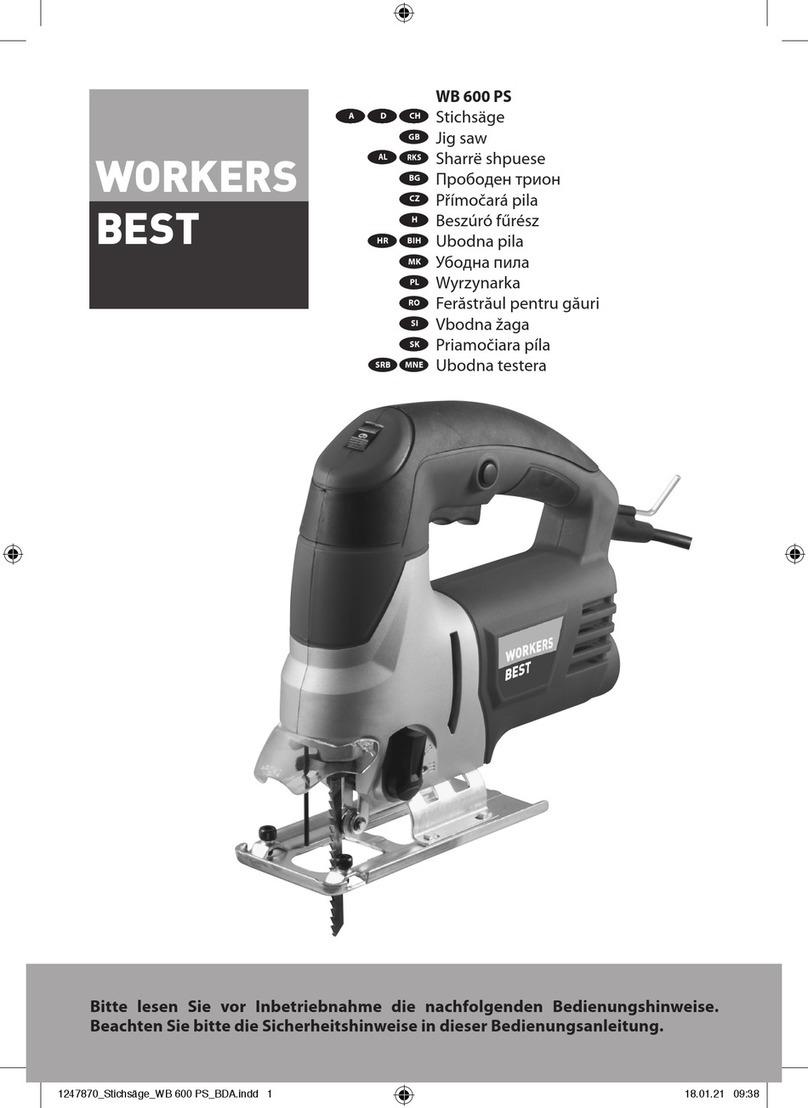
WORKERS BEST
WORKERS BEST WB 600 PS manual
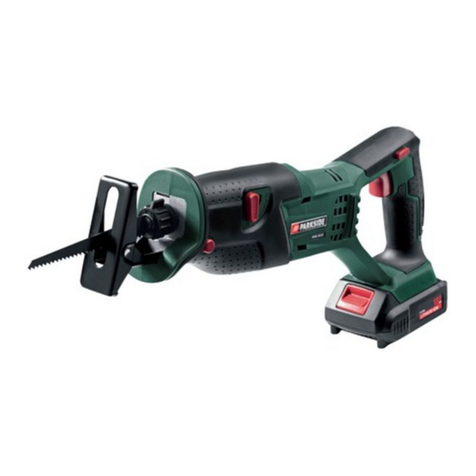
Parkside
Parkside PSSA 18 A1 Translation of the original instructions
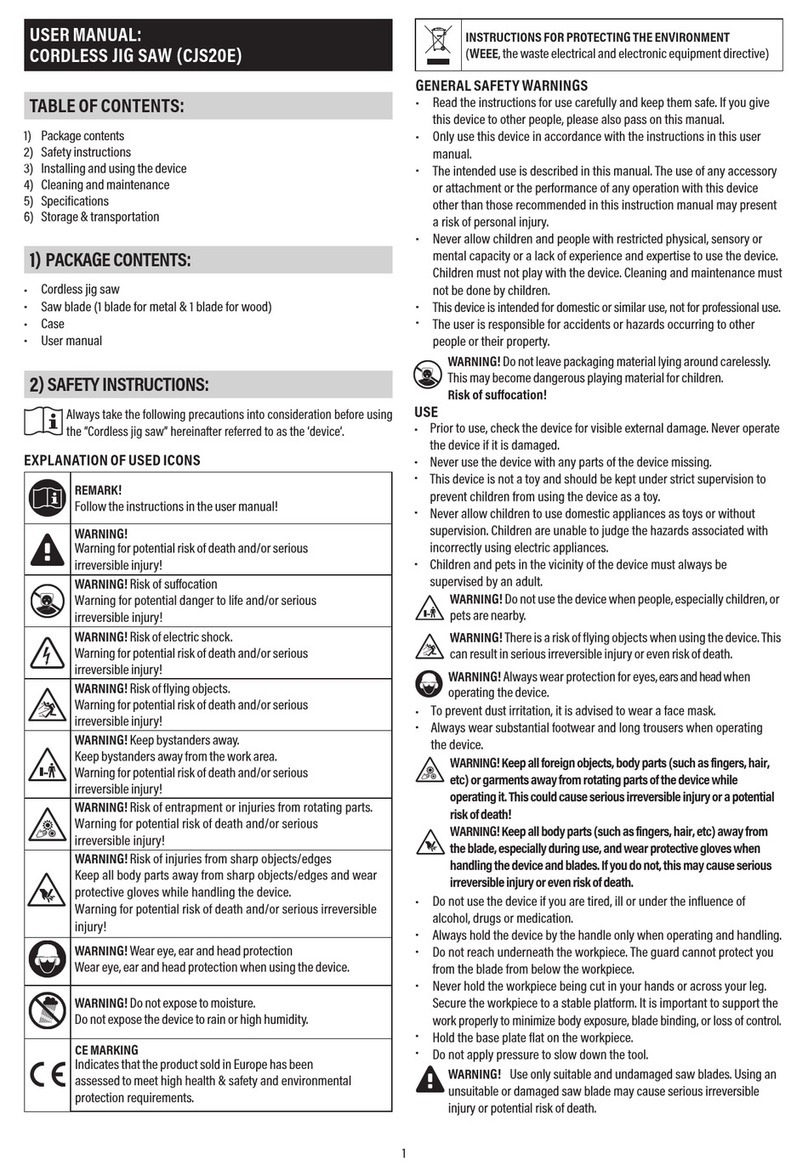
MASCOT
MASCOT CJS20E user manual
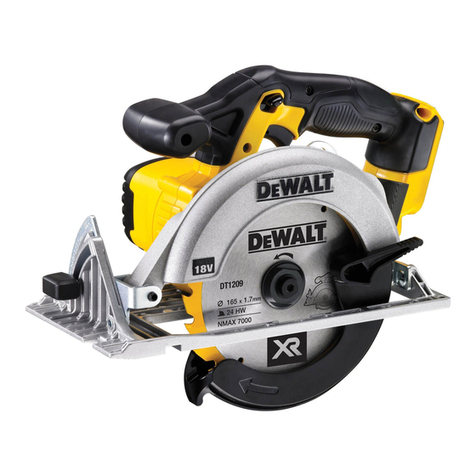
DeWalt
DeWalt XR DCS391 Original instructions
